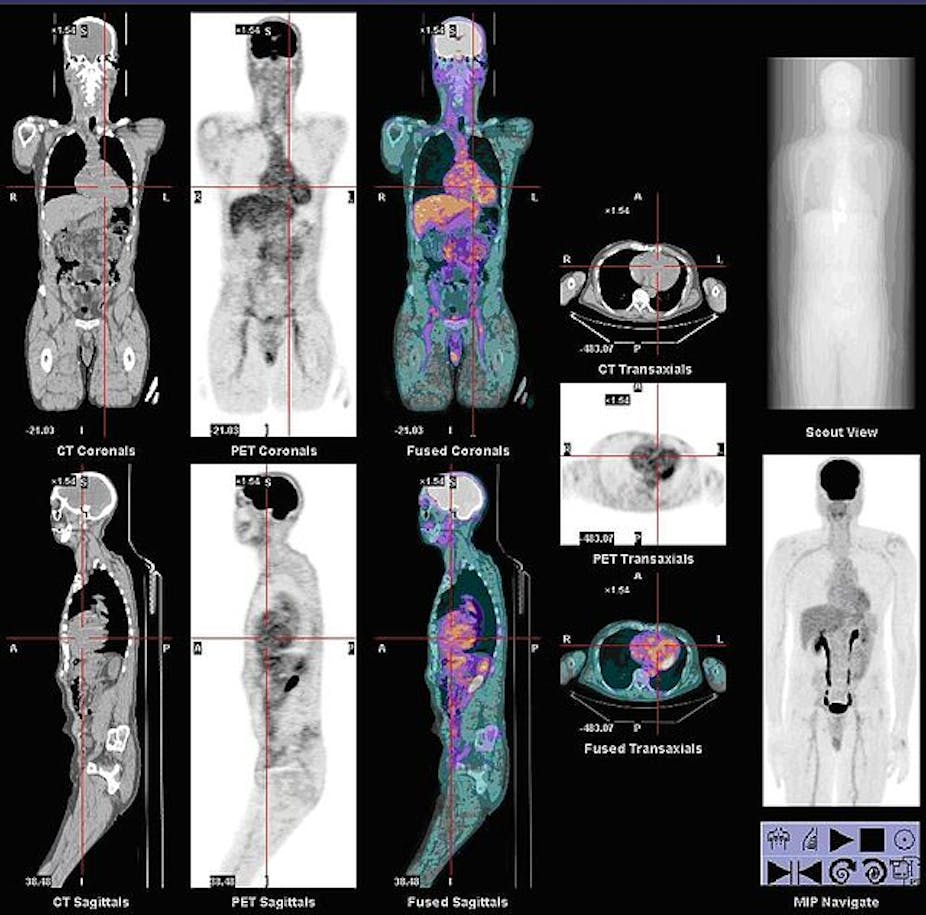Technetium-99m is the world’s most commonly used medical isotope, used for over 30 million medical diagnostic procedures annually. But recent years have seen severe worldwide shortages and price spikes as the nuclear reactors responsible for supplying the global demand for medical radioisotopes shut down for maintenance, or are decommissioned after decades of service. This has led experts to ponder how to prevent supplies running out in the future.
Technetium was the first synthetic element, one that does not occur naturally, discovered by Carlo Perrier and Emilio Segre in Italy in 1937. Named from the Greek word technetos meaning artificial, all its isotopes are radioactive.
Use of Tc99m accounts for 80% of all diagnostic nuclear medicine investigations. These generally involve the administration of a tracer radionuclide such as Tc99m. A scan using a gamma camera picks up the gamma rays emitted by the tracer and reveals its progression and distribution through the body. This allows crucial investigations including bone, heart, brain, kidney and tumour imaging.
Technetium-99m is produced in hospitals from Molybdenum-99, which is delivered on a weekly basis in the form of a technetium-molybdenum generator. This is a self-contained device about the size of a coffee maker. Flushing the generator with sterile saline solution on a daily basis provides a fresh brew of technetium ready for use in scanning patients.
For more than 30 years hospitals have relied on regular refills of molybdenum for the routine production of these vital agents. But the increasing disruptions experienced by hospitals’ nuclear medicine departments have caused supplies to dry up. May this year and just last week have been critical periods of short supplies when some of the nuclear reactors producing the molybdenum have been shut down for maintenance.
Limited and shrinking supply
The production of the world supplies of medical molybdenum is provided by six nuclear reactor sites: the NRU at Chalk River Laboratories in Canada, HFR at Petten in the Netherlands, BR-2 in Fleurus, Belgium, OSIRIS in Saclay, France, SAFARI-1 in Pelindaba, South Africa and OPAL in Sydney, Australia. NRU and HFR generate 80% of global molybdenum production, with the first five generating 95% in total.
These reactors were originally built for research and for the production of research radioisotopes, and were never involved in generating electrical power. Over the years producing medical radionuclides has become an important part of these reactors’ operations, accounting for around a third of their business. The simple explanation for the increasingly fragile nature of molybdenum supplies is that all but OPAL are more than 40 years old and are increasingly unrealiable as they approach the end of their operational life.
The first real problems started to emerge in 2007, with the unanticipated closure of the Chalk River facility, which immediately reduced the replenishment of isotope stocks in North American hospitals by about 80%, causing much panic and the cancellation of some 50,000 medical procedures over five weeks. This was exacerbated by the shutdown of the Dutch, Belgian and French reactors at the same time. Chalk River closed again in 2009 for a year, causing further supply problems.
Since then hospital departments have had to reschedule patients or offer alternative investigations during periods of short supply. Although hospital departments, medical societies and commercial suppliers have adapted and improved procedures to minimise any disruption, the problem is not going to go away. The problem of supply is aggravated by the short physical half-life of Tc99m which, at only 6 hours, means regular production and an efficient supply chains is essential.
A gap yet to be plugged
The NRU reactor at Chalk River Laboratories, which produces approximately 40% of the world’s medical molybdenum supplies, will close in 2016. OSIRIS, BR-2 and HFR are also due to close within the next five years. Two reactors planned as replacements for NRU, Maple-1 and 2, were cancelled in 2008.
Some additional molybdenum is coming from Poland and Russia is preparing to ship materials to the west. New reactors are planned in France, the Netherlands and the US, which as the world’s biggest consumer is looking at other means of meeting its needs with universities in Illinois and Missouri ramping up production. Canada is also investing in alternative production technologies similar to those used for the production of isotopes for PET scanning.
The prospect of “radioinactivity” has been of concern in other fields. NASA has recently expressed concern about the dwindling supply of radioactive sources, especially plutonium-238 for the thermoelectric batteries that power deep space probes. In the past such plutonium supplies came as a side benefit from an active nuclear weapons programme that required plutonium-239, but as these have been cancelled, in the US in 1987 and in Russia in 2003, supplies have all but run out.
In medicine this has served as a reminder of the need to secure supplies of medical isotopes for vital medical procedures where there is no alternative. Building and commissioning nuclear reactors takes many years, and this may be one solution given a potential revival of nuclear technology as a sustainable, carbon-free form of energy. Other production methods such as linear accelerator photo-fission, or production using the cyclotrons found in some larger hospital radiopharmacies need further development.
With tens of millions of procedures conducted worldwide every year, upon which the health of millions of patients rely, clearly there remains an urgent need to invest in the technology to secure future supplies of medical molybdenum and technetium.

